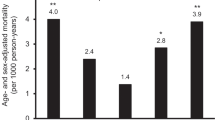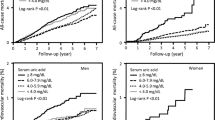Abstract
The Working Group on Uric Acid and Cardiovascular Risk of the Italian Society of Hypertension conceived and designed an ad hoc study aimed at searching for prognostic cut-off values of serum uric acid (SUA) in predicting combined (fatal and non-fatal) cerebrovascular (CBV) events in the whole database. The URic acid Right for heArt Health study is a nationwide, multicenter, observational cohort study involving data on subjects aged 18–95 years recruited on a regional community basis from all the territory of Italy under the patronage of the Italian Society of Hypertension with a mean follow-up period of 120.7 ± 61.8 months. A total of 14,588 subjects were included in the analysis. A prognostic cut-off value of SUA able to discriminate combined CBV events (>4.79 mg/dL or >284.91 µmol/L) was identified by means of receiver operating characteristic curve in the whole database. Multivariate Cox regression analysis adjusted for confounders (age, sex, arterial hypertension, diabetes, chronic kidney disease, smoking habit, ethanol intake, body mass index, low-density lipoprotein cholesterol, and use of diuretics) identified an independent association between SUA and combined CBV events in the whole database (HR 1.249, 95% confidence interval, 1.041–1.497, p = 0.016). The results of the present study confirm that SUA is an independent risk marker for CBV events after adjusting for potential confounding variables, including arterial hypertension, and demonstrate that >4.79 mg/dL is a valid prognostic cut-off value.
This is a preview of subscription content, access via your institution
Access options
Subscribe to this journal
Receive 12 digital issues and online access to articles
$119.00 per year
only $9.92 per issue
Buy this article
- Purchase on Springer Link
- Instant access to full article PDF
Prices may be subject to local taxes which are calculated during checkout



Similar content being viewed by others
References
Culleton BF, Larson MG, Kannel WB, Levy D. Serum uric acid and risk for cardiovascular disease and death: the Framingham Heart Study. Ann Intern Med. 1999;131:7–13.
Fang J, Alderman MH. Serum uric acid and cardiovascular mortality the NHANES I epidemiologic follow-up study, 1971-1992. National Health and Nutrition Examination Survey. JAMA. 2000;283:2404–10.
Rahimi-Sakak F, Maroofi M, Rahmani J, Bellissimo N, Hekmatdoost A. Serum uric acid and risk of cardiovascular mortality: a systematic review and dose-response meta-analysis of cohort studies of over a million participants. BMC Cardiovasc Disord. 2019;19:218.
Odden MC, Amadu AR, Smit E, Lo L, Peralta CA. Uric acid levels, kidney function, and cardiovascular mortality in US adults: National Health and Nutrition Examination Survey (NHANES) 1988–1994 and 1999–2002. Am J Kidney Dis. 2014;64:550–7.
Bos MJ, Koudstaal PJ, Hofman A, Witteman JC, Breteler MM. Uric acid is a risk factor for myocardial infarction and stroke: the Rotterdam study. Stroke. 2006;37:1503–7.
Becker BF. Towards the physiological function of uric acid. Free Radic Biol Med. 1993;14:615e31.
Nieto FJ, Iribarren C, Gross MD, Comstock GW, Cutler RG. Uric acid and serum antioxidant capacity: a reaction to atherosclerosis. Atherosclerosis. 2000;148:131e9.
Steinberg HO, Brechtel G, Johnson A, Fineberg N, Baron AD. Insulin-mediated skeletal muscle vasodilation is nitric oxide dependent. A novel action of insulin to increase nitric oxide release. J Clin Invest. 1994;94:1172e9.
Li M, Hou W, Zhang X, Hu L, Tang Z. Hyperuricemia and risk of stroke: a systematic review and meta-analysis of prospective studies. Atherosclerosis. 2014;232:265–70.
Kim SY, Guevara JP, Kim KM, Choi HK, Heitjan DF, Albert DA. Hyperuricemia and risk of stroke: a systematic review and meta-analysis. Arthritis Rheum. 2009;61:885–92.
Desideri G, Virdis A, Casiglia E, Borghi C. Exploration into uric and cardiovascular disease: Uric Acid Right for heArt Health (URRAH) Project. A study protocol for a retrospective observational study. High Blood Press Cardiovasc Prev. 2018;25:197–202.
Casiglia E, Tikhonoff V, Virdis A, Masi S, Barbagallo CM, Bombelli M, et al. Serum uric acid and fatal myocardial infarction: detection of prognostic cut-off values: The URRAH (Uric Acid Right for Heart Health) study. J Hypertens. 2020;38:412–9.
Virdis A, Masi S, Casiglia E, Tikhonoff V, Cicero AFG, Ungar A, et al. Identification of the uric acid thresholds predicting an increased total and cardiovascular mortality over 20 years. Hypertension. 2020;75:302–8.
Muiesan ML, Salvetti M, Virdis A, Masi S, Casiglia E, Tikhonoff V, et al. Serum uric acid predicts heart failure in a large Italian cohort: search for a cut-off value the URic acid Right for heArt Health study. J Hypertens. 2021;39:62–9.
Levey AS, Stevens LA, Schmid CH, Zhang YL, Castro AF, Feldman HI, et al. A new equation to estimate glomerular filtration rate. Ann Intern Med. 2009;150:604–12.
Casiglia E, Palatini P. Cardiovascular risk factors in the elderly. J Hum Hypertens. 1998;12:575–81.
Casiglia E, Spolaore P, Ginocchio G, Colangeli G, Di Menza G, Marchioro M, et al. Predictors of mortality in very old subjects aged 80 years or over. Eur J Epidemiol. 1993;9:577–86.
DeLong ER, DeLong DM, Clarke-Pearson DL. Comparing the areas under two or more correlated receiver operating characteristic curves: a nonparametric approach. Biometrics. 1988;44:837–45.
Kamarudin AN, Cox T, Kolamunnage-Dona R, Time-dependent ROC. curve analysis in medical research: current methods and applications. BMC Med Res Methodol. 2017;17:53.
Youden WJ. Index for rating diagnostic tests. Cancer. 1950;3:32–5.
Schisterman EF, Perkins NJ, Liu A, Bondell H. Optimal cut-point and its corresponding Youden index to discriminate individuals using pooled blood samples. Epidemiology. 2005;16:73–81.
Mazza A, Zamboni S, Tikhonoff V, Schiavon L, Pessina AC, Casiglia E. Body mass index and mortality in elderly men and women from general population. Gerontology. 2007;53:36–45.
Maloberti A, Bombelli M, Facchetti R, Desideri G, Cicero AFG, Muiesan ML, et al. Relationships between diuretic-related hyperuricemia and cardiovascular events: data from the URRAH (URic acid Right for heArt Health) study. J Hypertens. 2021;39:333–40.
Alderman MH, Cohen H, Madhavan S, Kivlighn S. Serum uric acid and cardiovascular events in successfully treated hypertensive patients. Hypertension. 1999;34:144–50.
Casiglia E, Mazza A, Tikhonoff V, Pavei A, Privato G, Schenal N, et al. Weak effect of hypertension and other classic risk factors in the elderly who have already paid their toll. J Hum Hypertens. 2002;16:21–31.
Zhong C, Zhong X, Xu T, Xu T, Zhang Y. Sex‐specific relationship between serum uric acid and risk of stroke: a dose‐response meta‐analysis of prospective studies. J Am Heart Assoc. 2017;6:pii:e005042.
Ruoff G, Edwards NL. Overview of serum uric acid treatment targets in gout: why less than 6 mg/dl? Postgrad Med. 2016;128:706–15.
Khanna D, Fitzgerald JD, Khanna PP, Bae S, Singh MK, Neogi T, et al. 2012 American College of Rheumatology guidelines for management of gout. Part 1: systematic nonpharmacologic and pharmacologic therapeutic approaches to hyperuricemia. Arthritis Care Res. 2012;64:1431–46.
Storhaug HM, Norvik JV, Toft I, Eriksen BO, Løchen ML, Zykova S, et al. Uric acid is a risk factor for ischemic stroke and all-cause mortality in the general population: a gender specific analysis from The Tromsø Study. BMC Cardiovasc Disord. 2013;13:115.
Xu Y, Zhu J, Gao L, Liu Y, Shen J, Shen C, et al. Hyperuricemia as an independent predictor of vascular complications and mortality in type 2 diabetes patients: a meta-analysis. PLoS One. 2013;8:e78206.
Du L, Ma J, Zhang X. Higher serum uric acid may contribute to cerebral infarction in patients with type 2 diabetes mellitus: a meta-analysis. J Mol Neurosci. 2017;61:25–31.
Burnier M, Bakris G, Williams B. Redefining diuretics use in hypertension: why select a thiazide-like diuretic? J Hypertens. 2019;37:1574–86.
Jin M, Yang F, Yang I, Yin Y, Luo JJ, Wang H, et al. Uric acid, hyperuricemia and vascular diseases. Front Biosci. 2012;17:656–69.
Suarna C, Dean RT, May J, Stocker R. Human atherosclerotic plaque contains both oxidized lipids and relatively large amounts of alpha–tocopherol and ascorbate. Arterioscler Thromb Vasc Biol. 1995;15:1616–24.
Visy JM, LeCoz P, Chadefaux B, Fressinaud C, Woimant F, Marquet J, et al. Homocystinuria due to 5,10–methylenetetrahydrofolate reductase deficiency revealed by stroke in adult siblings. Neurology. 1991;41:1313–5.
Kanbay M, Segal M, Afsar B, Kang DH, Rodriguez-Iturbe B, Johnson RJ. The role of uric acid in the pathogenesis of human cardiovascular disease. Heart. 2013;99:759–66.
De Scheeder IK, van de Kraay AM, Lamers JM, Koster JF, deJong JW, Serruys PW. Myocardial malondialdehyde and uric acid release after short-lasting coronary occlusions during angioplasty: potential mechanisms for free radical generation. Am J Cardiol. 1991;68:392–5.
Tikhonoff V, Kuznetsova T, Stolarz K, Bianchi G, Casiglia E, Kawecka-Jaszcz K, et al. β-adducin polymorphism, blood pressure, and sodium excretion in three European populations. Am J Hypert. 2003;16:840–6.
Funding
This work has been conducted with an unrestricted grant from the Fondazione of the Italian Society of Hypertension (grant: MIOL).
Author information
Authors and Affiliations
Consortia
Contributions
Conception and design: VT, EC. Acquisition of data: VT, EC, PS, CMB, MB, AFGC, MC, PC, GD, LD, CF, FG, LG, CG, GI, FM, AM, SM, AM, MLM, PN, PP, GP, RP, FQ-T, MR, GR, MS, GT, AU, PV, FV, AV, MV, GG, CB. Analysis and interpretation of data: VT, EC. Drafting of the manuscript or revising it critically for important intellectual content: VT, EC, GB, CF, FG, CG, FM, MLM, PP, GP, RP, AU, PV, AV, MV, GG, CB. Final approval of the manuscript submitted: VT, EC, PS, CMB, MB, AFGC, MC, PC, GD, LD, CF, FG, LG, CG, GI, FM, AM, SM, AM, MLM, PN, PP, GP, RP, FQ-T, MR, GR, MS, GT, AU, PV, FV, AV, MV, GG, GB.
Corresponding author
Ethics declarations
Competing interests
The authors declare no competing interests.
Additional information
Publisher’s note Springer Nature remains neutral with regard to jurisdictional claims in published maps and institutional affiliations.
Supplementary information
Rights and permissions
About this article
Cite this article
Tikhonoff, V., Casiglia, E., Spinella, P. et al. Identification of a plausible serum uric acid cut-off value as prognostic marker of stroke: the Uric Acid Right for Heart Health (URRAH) study. J Hum Hypertens 36, 976–982 (2022). https://doi.org/10.1038/s41371-021-00613-5
Received:
Revised:
Accepted:
Published:
Issue Date:
DOI: https://doi.org/10.1038/s41371-021-00613-5
This article is cited by
-
The Results of the URRAH (Uric Acid Right for Heart Health) Project: A Focus on Hyperuricemia in Relation to Cardiovascular and Kidney Disease and its Role in Metabolic Dysregulation
High Blood Pressure & Cardiovascular Prevention (2023)
-
Serum Uric Acid Levels and Cardiometabolic Profile in Middle-Aged, Treatment-Naïve Hypertensive Patients
High Blood Pressure & Cardiovascular Prevention (2022)



